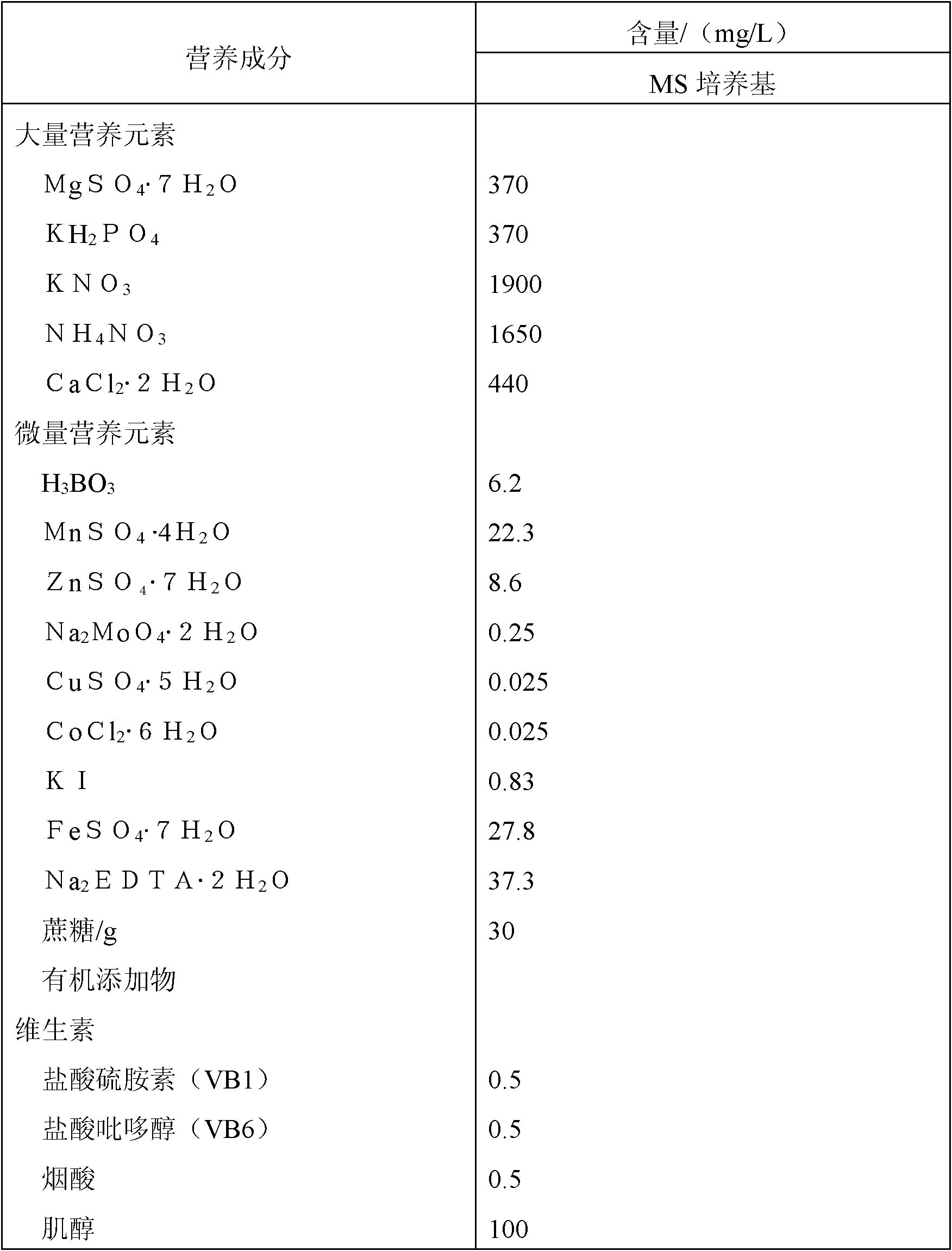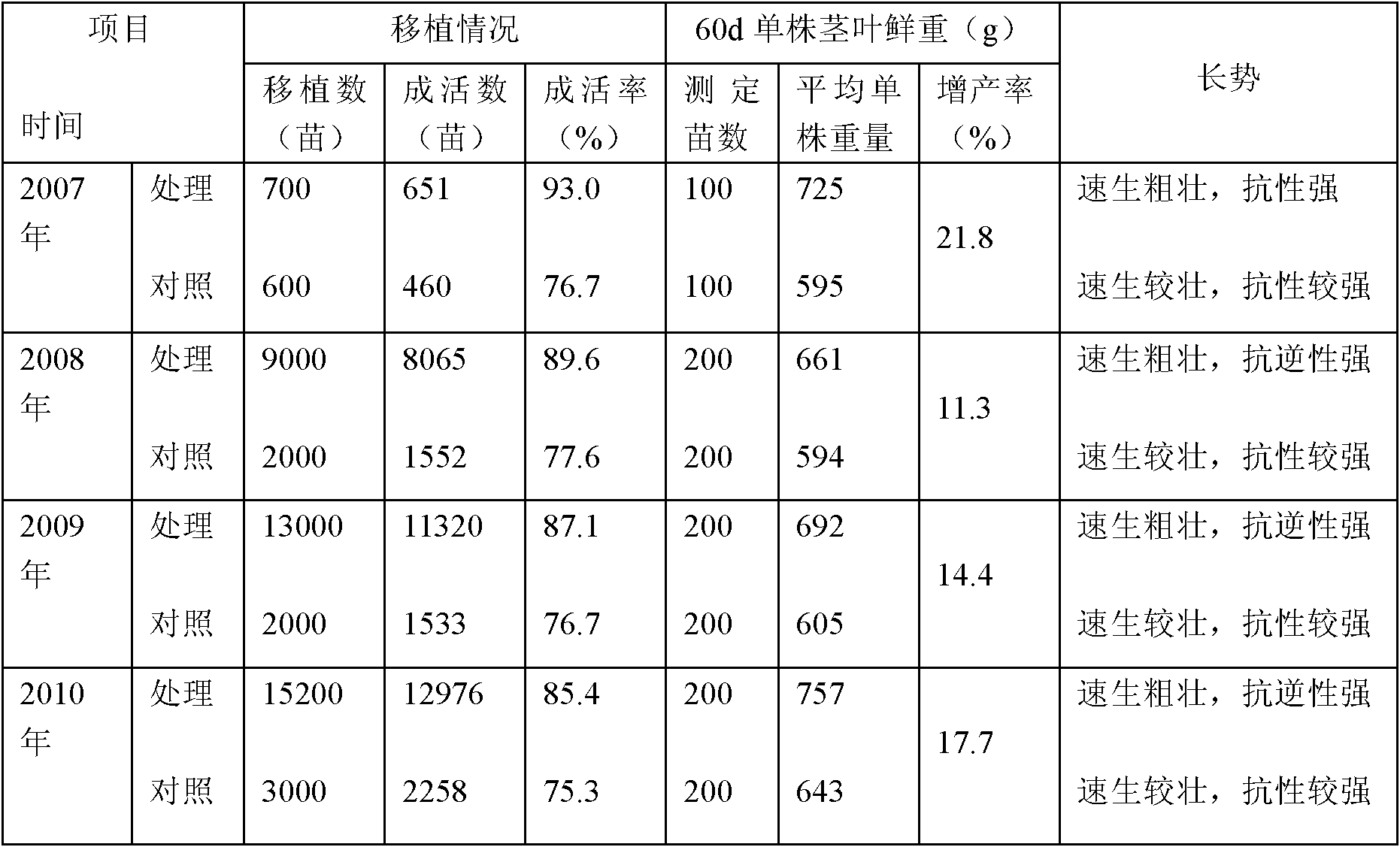Rapid lotus corniculatus l. breeding method
A fast technology of L. japonicus, which is applied in the field of fast propagation of L. japonicus, can solve the problems affecting the normal development and growth of the root system, and achieve good growth of the seedling root system, strong growth of the plant and root system, and strong meristemality. Effect
- Summary
- Abstract
- Description
- Claims
- Application Information
AI Technical Summary
Problems solved by technology
Method used
Image
Examples
Embodiment 1
[0028] Disinfect 0.5-1 g (1,000-grain weight 1-1.2 g) mature plump seeds of japonicus japonicus with 0.1% mercuric chloride solution for 20 minutes, and rinse them with sterile water; In the petri dish of filter paper, germinate under light for 5 days; transfer the germinated seeds to the MS basic medium without hormones, room temperature 25-27 ℃, light intensity 2000lux, 12h light time per day, and cultivate for 25 days; Take out when it grows to 10-12cm in length, cut into sections under sterile conditions, each stem section is about 1.5cm long, with 1 mature leaf; transfer the stem section into a bottle containing disposable growth medium, and cut 20 stems in each bottle Segment; After cutting the stem segment, place the bottle in a room temperature of 25-27°C, 2000 lux, and 12 hours of light per day for cultivation. After 25 days, the bottle can be transplanted or subcultured.
[0029] Among them, the one-time growth medium formula is the complete nutrient composition of M...
Embodiment 2
[0031] 0.5-1 gram (dry weight 1-1.2 grams) of japonicus japonicus mature plump seeds are sterilized with 0.1% mercuric chloride for 20 minutes, and rinsed with sterile water; the rinsed japonicus japonicus seeds are placed in a sterile state containing In a petri dish with wet filter paper, germinate under light for 3-5 days; transfer the germinated seeds to MS basic medium without hormones, at room temperature 25-27°C, light intensity 2000lux, 12h light per day, and culture for 20-20 25 days; take out the buds when they grow to 10-12cm in length, cut into sections under sterile conditions, each stem section is about 2cm long, with 1 mature leaf; transfer the stem section into a bottle containing a disposable growth medium, each bottle Cut 20 stem segments; after the stem segments are cut, place the bottle in a room temperature of 25-27°C, 3000 lux, and 12 hours of light per day for cultivation. After 20 days, the bottle can be transplanted or subcultured.
[0032] Among them,...
Embodiment 3
[0034] In recent years, many batches of japonicus japonicus plants have been propagated with this technology. Through field planting, multiple variety transplantation comparison tests have been carried out with conventional seedlings (control). Planting, the growth period is three months, and the result is that the survival rate of clone transplantation is increased by about 10% to 15% compared with the control, and the plant grows strongly and grows fast. During the 4 years from 2007 to 2010, the fresh weight of the stems and leaves of the japonicus plants planted in autumn and grown in the field for 60 days were measured in November every year. 100 treated plants were measured each time, and 100 seeds were sown at the same time. Seedling plant is as contrast, measures hundreds of stems and leaves fresh weight and gets average value (average single plant fresh weight=100 stems and leaves total fresh weight (gram) / 100), measures continuously 4 years, and the result shows, the c...
PUM
 Login to View More
Login to View More Abstract
Description
Claims
Application Information
 Login to View More
Login to View More - R&D
- Intellectual Property
- Life Sciences
- Materials
- Tech Scout
- Unparalleled Data Quality
- Higher Quality Content
- 60% Fewer Hallucinations
Browse by: Latest US Patents, China's latest patents, Technical Efficacy Thesaurus, Application Domain, Technology Topic, Popular Technical Reports.
© 2025 PatSnap. All rights reserved.Legal|Privacy policy|Modern Slavery Act Transparency Statement|Sitemap|About US| Contact US: help@patsnap.com



